
Prostanthera eurybioides, commonly known as Monarto mintbush, is a species of flowering plant in the family Lamiaceae and is endemic to the south-east of South Australia. It is a low, spreading shrub with densely hairy branches, thick, elliptic to egg-shaped leaves clustered on short shoots, and violet to mid-purple flowers that are white with orange and dark purple dots inside the petal tube.
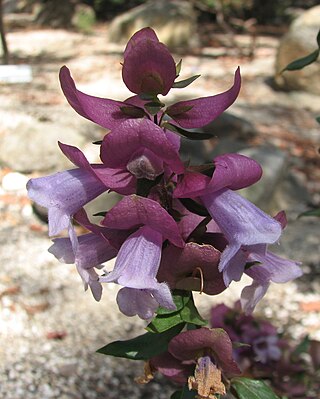
Prostanthera magnifica, commonly known as magnificent prostanthera, is a species of flowering plant in the family Lamiaceae and is endemic to Western Australia. It is a slender to spreading, erect shrub that has hairy stems, elliptical to narrow egg-shaped leaves and pale mauve or pale blue to pink flowers with prominent dark mauve to purple sepals.

Prostanthera stenophylla is a species of flowering plant in the family Lamiaceae and is endemic to Wollemi National Park in New South Wales. It is an erect, slender, aromatic shrub with hairy, oblong leaves and small groups of pale bluish mauve to violet flowers.

Prostanthera porcata is a species of flowering plant in the family Lamiaceae and is endemic to the Budawang Range in south-eastern New South Wales. It is a small, erect shrub with glabrous branches, elliptic leaves and deep pink or pink and cream-coloured flowers.
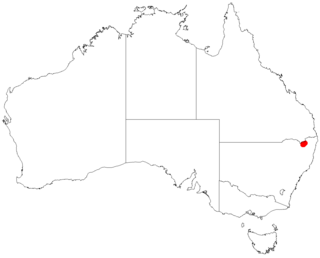
Prostanthera staurophylla, commonly known as Tenterfield mint-bush, is a species of flowering plant in the family Lamiaceae and is endemic to a small area on the New England Tableland of New South Wales. It is an erect to spreading, strongly aromatic shrub with hairy branches, deeply lobed leaves and bluish-mauve flowers with darker markings.

Prostanthera prostantheroides is a plant in the family Lamiaceae and is endemic to Western Australia. It is a shrub with heart-shaped to round leaves and usually white flowers with purple spots inside the petal tube.
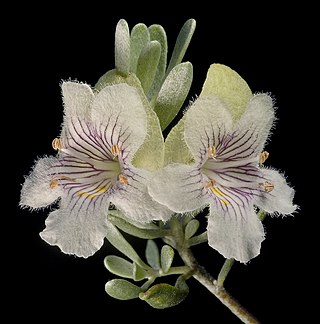
Prostanthera althoferi is a species of flowering plant in the family Lamiaceae and is endemic to inland areas of Australia. It is an erect shrub with its stems and leaves densely covered with silvery, greyish-green hairs, and has narrow egg-shaped leaves and white to cream-coloured flowers with mauve or purple striations inside.
Prostanthera athertoniana is a species of flowering plant in the family Lamiaceae and is endemic to a restricted area of Queensland. It is a small, densely-foliaged shrub with strongly aromatic, elliptical, oblong or egg-shaped leaves and hairy, purplish-mauve flowers arranged singly in upper leaf axils.

Prostanthera canaliculata is a species of flowering plant in the family Lamiaceae and is endemic to the south-west of Western Australia. It is a small, erect shrub with hairy branchlets, narrow egg-shaped to narrow elliptical leaves and pale blue or pale violet to white flowers with no markings.
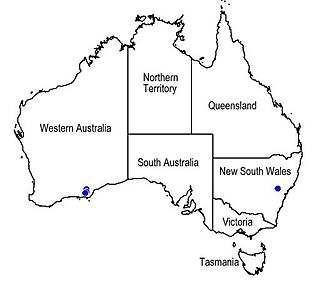
Prostanthera carrickiana, commonly known as Carrick's mintbush, is a species of flowering plant in the family Lamiaceae and is endemic to a restricted area in the south-west of Western Australia. It is an erect shrub with hairy branchlets, elliptical leaves pinkish-red flowers.

Prostanthera eungella is a species of flowering plant in the family Lamiaceae and is endemic to the Eungella region in Queensland. It is an erect shrub with narrow egg-shaped leaves with small teeth, and mauve flowers that are white inside the petal tube and arranged in upper leaf axils.
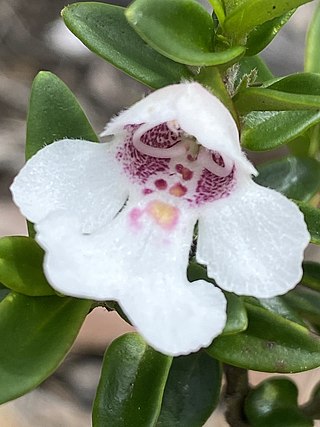
Prostanthera gilesii is a species of flowering plant in the family Lamiaceae and is endemic to the Mount Canobolas area of New South Wales. It is a small, compact, spreading shrub with aromatic, narrow egg-shaped to elliptical leaves, and white to yellowish white flowers with purple to dark mauve markings inside the petal tube and pale orange markings on the petal lobes.
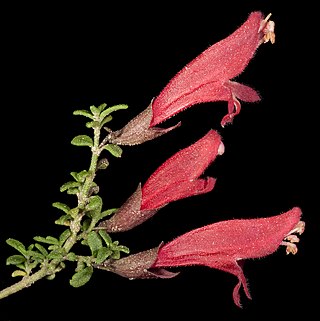
Prostanthera grylloana is a species of flowering plant in the family Lamiaceae and is endemic to Western Australia. It is a small, erect shrub with densely hairy branchlets, small, spatula-shaped leaves and red to pink flowers.

Prostanthera laricoides is a species of flowering plant in the family Lamiaceae and is endemic to the inland of Western Australia. It is a small shrub with densely hairy, densely glandular branchlets, cylindrical leaves clustered near the ends of branchlets, and dull, light red flowers.
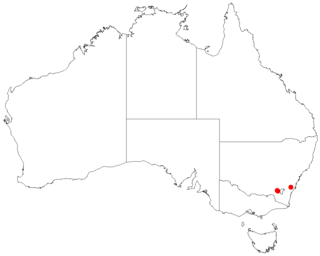
Prostanthera makinsonii is a species of flowering plant in the family Lamiaceae and is endemic to a restricted area of New South Wales. It is a spreading shrub with strongly aromatic, egg-shaped leaves and mostly glabrous purple flowers arranged in bunches of eight to twelve in upper leaf axils.

Prostanthera oleoides is a species of flowering plant that is endemic to central Queensland. It is an open, erect shrub with four-sided branchlets, narrow elliptic, oblong or egg-shaped leaves with the narrower end towards the base, and mauve flowers with purple to dark mauve markings.

Prostanthera patens is a species of flowering plant in the family Lamiaceae and is endemic to Western Australia. It is a small shrub with stiff, spine-like, hairy branches, egg-shaped to broadly elliptic, hairy leaves and red and orange to pale red flowers.
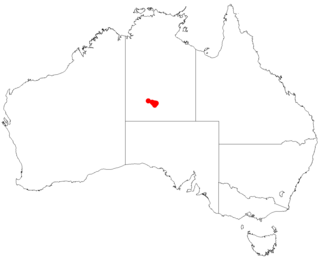
Prostanthera schultzii is a species of flowering plant in the family Lamiaceae and is endemic to the Northern Territory. It is a shrub with heart-shaped to round or paddle-shaped leaves and white flowers with purple spots and yellow patches on the lower lip.
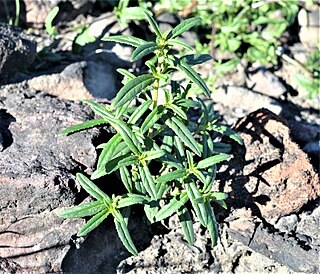
Prostanthera tallowa is a species of flowering plant in the family Lamiaceae and is endemic to the Kangaroo Valley area of New South Wales. It is an erect, aromatic shrub with narrow egg-shaped to linear leaves and mauve to light purple flowers with darker dots inside the petal tube.

Prostanthera verticillaris is a species of flowering plant in the family Lamiaceae and is endemic to a restricted area of Western Australia. It is a spreading shrub with whorled, egg-shaped to elliptic leaves and white to purplish-blue flowers.




















